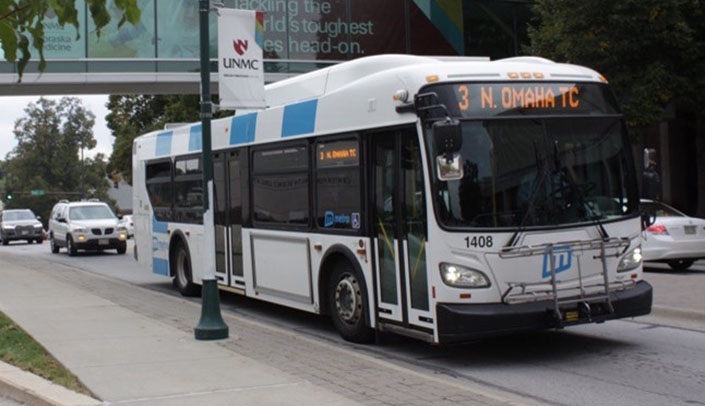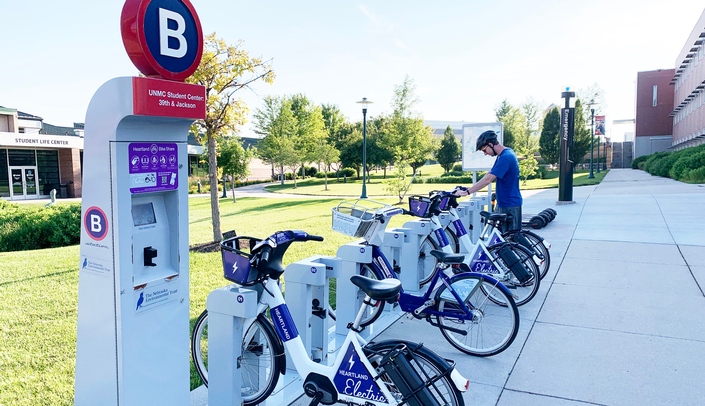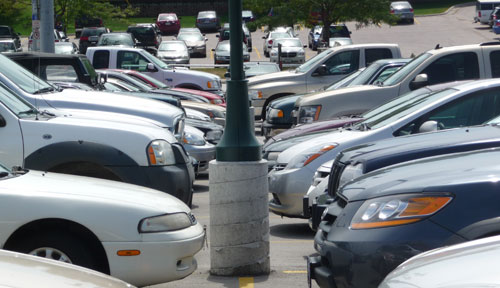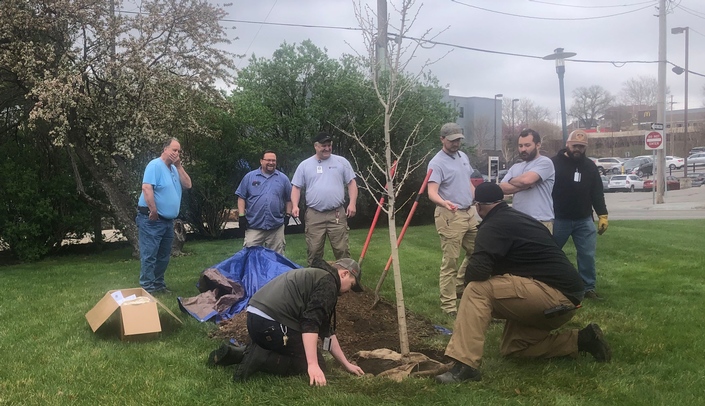Transit users must be registered for TravelSmart

On Monday, Aug. 1, all med center employees will be required to have registered for TravelSmart in order to use their ID badges to ride Metro transit buses.
Colleagues who rely on the bus to get to or from work should make sure they are registered before that date. There will be a short grace period, but employees will not be permitted to ride Metro buses without a badge connected to an active TravelSmart account.
After registering, people should expect a 48-hour delay before a card is turned on. Employees who already registered for TravelSmart do not need to re-register.
For the last year, employees have not been required to swipe their badges because a new payment system was in place. That is no longer active. On ORBT buses after Aug. 1, all med center employees will be expected to tap their badges instead of simply showing the driver.
TravelSmart transit benefits also apply to employees who rely on MOBY. MOBY is Metro’s shared, complementary ADA paratransit service for users who cannot access existing routes due to a disability or a disabling health condition. Riders must register to use MOBY and use their ID badge.
Now is a great time to try the bus system. There are several health benefits associated with mass transit. As more people use public transportation, there are fewer cars on the road emitting harmful pollutants. Increased use of public transportation also leads to a reduction in the need for parking, which costs money, takes up space and has a large carbon footprint associated with the energy intensive production of concrete.
Plus, improved urban air quality is healthier. Air pollution has many connections to public health issues, including myocardial ischemia, chest pain, coughing, throat irritation and more. And there is a much lower rate of passenger death rates for buses compared to passenger vehicles.
Free, first-year bike share memberships now available

UNMC and Nebraska Medicine are launching a new TravelSmart benefit to provide a free, first-year bike share membership to students, faculty and staff with med center email addresses.
Bike sharing systems allow members to easily unlock, ride and return bikes and electric pedal-assist bikes at a network of docking stations around the city. Omaha’s bike share system, Heartland B-cycle, features about 70 stations throughout the city.
Because there are a limited number of free Heartland B-cycle memberships available, interested students, faculty and staff should sign up as soon as possible — first via TravelSmart and then through the Heartland B-cycle app using a special promo code. Detailed instructions for how to sign up for the free membership are provided below and also on the LiveGreen TravelSmart website.
Please note that new members will be required to input credit card information but will not be charged except in the event that they check out a bike for longer than 60 minutes. The med center program covers all costs associated with trips under one hour. Heartland B-cycle will never auto-renew the membership by charging the card on file.
How to sign up for a free Heartland B-cycle membership:
- Regardless of status as either an existing TravelSmart program user or new participant, people must register for TravelSmart and choose the option for bicycle and any other offerings.
- Once registered for TravelSmart, participants will receive a confirmation email containing a special promo code.
- On the Heartland B-cycle website or app, follow the instructions to register for an annual membership. When prompted, enter the appropriate UNMC or Nebraska Medicine email address and the special code from the TravelSmart confirmation email.
- Input credit card information. (See note above.)
- Download the Heartland B-cycle app or use the website to find nearby docking stations. The number on each blue icon is the number of bikes currently available at that station. If the blue icon has a lightning bolt, there is currently an electric bike available.
Updated carpool pass is due

More than 500 people who work at the med center carpool to work. For active carpooling participants, an updated carpool pass is now due.
One carpool partner from each group needs to go in person to UNMC Parking Services, located at the Student Life Center Room 2002, to receive an updated carpool pass by July 15.
Now is a great time to test out carpooling. Carpooling groups save money: Groups get to park on campus for free and save money on gasoline by commuting to work together. Faculty, staff and students who start to carpool can continue to park in their existing parking lot or even a better lot, depending on the carpool partner.
By reducing emissions from vehicle exhaust, carpooling can improve both human health and environmental health.
For people who are interested in carpooling but don’t know a med center colleague to partner with, check out the Metro Rideshare carpool matching program. It is a great way to find other commuters at the med center who have a similar work schedule and lifestyle preferences.
Participants who sign up to carpool through TravelSmart also have access to an emergency ride home in case a carpooling partner has to leave work unexpectedly.
Energy curtailment season begins at the med center

The UNMC community is familiar with “energy curtailment,” when colleagues and students are asked to help the campus by using less energy on days when the combined heat and humidity put extra stress on campus energy systems. Starting today, the med center will be in and out of curtailment throughout the summer.
By using less energy on curtailment days, the med center:
- ensures continuity of essential systems for critical hospital and research functions;
- reduces pollution;
- improves the health of the entire community; and
- helps save money — both now (consumption) and for the next 12 months as the next year’s electrical rate is based on UNMC and Nebraska Medicine’s maximum usage at any given point in time. This is always important, but especially now, as budgets are tight.
So what simple things can be done to help?
- Close shades, blinds and curtains whenever possible to reduce solar heat gain;
- When on campus and others aren’t, please help by closing window coverings and turning off any lights or equipment not being used;
- Lower lighting levels where possible, turn off lights in unoccupied areas and when leaving a room;
- Turn off and unplug all electrical equipment not in use (computers, coffee makers, printers, chargers, etc.);
- Shut fume hood sashes when not in use;
- Open doors manually instead of using the ADA buttons if possible
- Take the stairs instead of the elevator; and
- Tell others.
Updated technology has allowed the med center to control curtailment better. It is possible that workspaces will get warmer as the day goes on, but there shouldn’t be any freezing spaces. For a full explanation, see the Energy Curtailment page.
Spaces are not controlled individually, the system cools larger areas. So while the med center has a temperature range to maintain, it’s possible a colleague’s individual space may not be the exact preferred temperature. Only call 402-552-3347 (Nebraska Medicine) or 402-559-4050 (UNMC) to report spaces colder than 66 degrees or warmer than 78 degrees.
Patient care and research spaces are not affected by energy curtailment.
Parking rates largely remain steady

Parking rates for UNMC and Nebraska Medicine faculty, staff and students will not increase for the upcoming fiscal year for 48 of 50 lots.
Review parking options and monthly rates on this map.
“In a time of inflation, UNMC and Nebraska Medicine have taken this into consideration and agreed not to raise parking rates for employees and students,” said Victoria Zajac, director of Auxiliary Services. “In addition to TravelSmart, we provide a variety of parking options that enable individuals to select what works best for them.”
Although most motorists will not incur a rate change, there are two campus lots that have been on an increase schedule to create equity with similar lots; those permit holders will be notified individually, Zajac said.
Permit holders are reminded that parking fees do not generate revenue for the medical center. Fees cover such annual operating expenses as ongoing repairs and maintenance of lots. They also cover land purchases, snow removal, security and enforcement, equipment, lot improvements and administrative costs.
Earth Month a success

The med center held a variety of events this year to commemorate Earth Month.
All month, med center team members participated in the online Drawdown Ecochallenge, where they earned points for individual actions. As a team, colleagues consumed 21 meatless or vegan meals, saved 116 pounds of carbon dioxide and conserved 780 gallons of water.
On April 6, local organizations including Hillside Solutions, City Sprouts, MAPA, Metro transit, Omaha Permaculture and OPPD came together to talk about their programs and how higher education students across the Omaha area can take action and get involved.
Then on April 12, presenters Peter Pellerito from the UNMC Center for Healthy Living and Lauren Monroe-Neal of Prepped by Lauren offered a virtual cooking demonstration focused on eating healthy and sustainably.
The annual personal document shredding and electronic recycling event took place April 19-20. It collected:
- 189 pounds of assorted media (VHS tapes, DVDs, CDs and floppy disks)
- 3,727 pounds of electronic waste
- 3,893 pounds of paper for shredding
- 198 pounds of alkaline batteries (approximately 3,000 batteries)
- 10 pounds of rechargeable/button batteries
That’s a total of 8,025 total pounds diverted from the landfill. That impact equates to approximately an estimated:
- 450 gallons of gasoline not consumed
- 4,426 pounds of coal not burned
- 4.7 acres of U.S. forests conserved in one year
- 152 incandescent lamps switched to LEDs
People also donated:
- $563 and a carload of food to the Maverick Food Pantry
- 38 pairs of eyeglasses to the Truhlsen Eye Clinic
- Three bags of pop tabs to Ronald McDonald House
The month ended with a tree planting to celebrate Arbor Day’s 150th Anniversary and the med center’s achievement of Tree Campus USA certification. A Ginkgo biloba tree was planted in the green space near 42nd and Farnam Streets.
Photo: A Ginkgo biloba tree was planted in the green space near 42nd and Farnam Streets to celebrate Arbor Day and the med center’s Tree Campus USA certification.
LiveGreen plans transportation week activities

May 16-23 is National Transportation Week!
A week to acknowledge all of the hard-working employees in the transportation industry. This year, the UNMC/Nebraska Medicine Office of Sustainability is celebrating with two activities:
- Selfie prize drawing: Staff, students and faculty are encouraged to take photos of themselves riding Metro transit from May 16-23. Photos submitted to this Kudoboard will be entered to win a drawing for a $50 Visa gift card.
- Ride along: Join a group of med center staff to ride Omaha Bus Rapid Transit (ORBT) from 42nd and Dodge streets down to the Bike Union Coffee House for a free coffee on Thursday, May 19. The group will meet at noon and return at 1 p.m.
When more people use public transportation, there are fewer cars on the road releasing emissions that pollute our air. Increased use of public transportation also reduces the need for parking, which costs money and takes up space. In Omaha, the average cost for a stall in a parking garage is about $119 per spot per month over the course of its lifetime.
Public transportation is great for the environment. In the United States, public transportation saves 6 billion gallons of gasoline annually, which is equivalent to the energy use of 6.7 million homes for one year. Not only does our transit system reduce vehicle emissions, it also supports our neighbors who can’t afford to or choose not to own a car, which AAA estimates costs $9,282 per year over the useful life of the vehicle.
Taking public transportation is also a healthier way to travel. Air pollution is a public health issue, including myocardial ischemia, chest pain, coughing, throat irritation and more. Even if taking public transit doesn’t work for your daily commute, swapping a few drive-alone trips each week has an impact.
If you are new to taking Metro transit in Omaha, the first thing you should do is sign up for Travelsmart to receive free bus passes. Then download Metro Omaha’s MyRide app to track the location of buses around town. Find more tips and tricks on how to ride the bus on the LiveGreen website.
Those who can’t make it to the ride along on May 19 can try to ride ORBT to an errand or lunch date sometime next week. ORBT buses come every 10 minutes and are equipped with WiFi, bike racks and air conditioning.
Earth Month 2022

April 22 is Earth Day, and the Med Center is celebrating Earth Month all April long!
Check out the list below to find out how you can participate in our Earth Month celebration.
Drawdown EcoChallenge – Online All Month
Visit the website to pledge to take a simple action, including educating yourself on a new topic. Join our team to earn points, win prizes, and make the planet better (oh, and help us beat UNO’s team!). Invite your friends and family to participate —the more, the merrier!
Higher Ed Roundtable – April 6, 6-7:30pm
Join this virtual webinar hosted by MCC/Creighton/UNMC/UNO to hear from local organizations (including Hillside Solutions, City Sprouts, MAPA, Metro Transit, Omaha Permaculture, and OPPD) about their programs and how you can get involved. Register here.
Eating Healthy and Sustainably – April 12, 6-7:30pm
Virtual event with guests Peter Pellerito from the Center for Healthy Living and Lauren Monroe-Neal from Prepped by Lauren. Peter will give a presentation about eating a nutritious diet, followed by a cooking demo from Lauren about how to cook and eat healthy and sustainable meals. Register here and add the event to your calendar!
Personal Document Shredding and Electronic, Battery, and Techno Trash Recycling – Tuesday April 19, 10am-6pm and Wednesday April 20, 6am-2pm
Our annual event, hosted in collaboration with UNO. Seedlings and wildflower seed packets will also be available, courtesy of the NRD. Details on the website. Interested in volunteering at the event? Click here.
Arbor Day Tree Planting – April 29, 10am
Join us on April 29 at 10am to celebrate Arbor Day and our achievement of Tree Campus USA certification with a tree planting event. Saplings and seed packets available courtesy of NRD. Location TBD. Check the Earth Month page for updates.
Earth Day Omaha Student Teambuilding Activity – April 23, 1-2:30pm
Join other students from UNO and Creighton at the Earth Day Omaha event to socialize, discuss, and play! Facilitators from UNO, UNMC, and Creighton will lead students through a series of low-risk activities designed to sharpen teambuilding skills and create fruitful dialogue about each organization’s sustainability efforts and what they can do to improve their campuses. We’ll meet by the grassy area behind the Children’s Tent next to the outdoor workout station. Challenge yourself and your fellow students in various scenarios while being outdoors and attending Omaha’s Earth Day celebration.
Eating healthy and sustainably

Diet choices affect not only an individual’s health. How people eat also has a significant impact on the planet.
Eating more sustainably can help improve health while ensuring the planet has enough resources to feed future generations.
Increases in food production over the past several decades have positively impacted life expectancy, hunger, infant and child mortality and poverty. Unfortunately, these changes also have shifted people toward unhealthier diets — high in processed foods, added sugar and animal products. This shift to modern diets, for all its convenience and low cost, can compromise human health and be detrimental to the environment, especially as the global population grows. Industrial agriculture consumes a lot of natural resources, leading to deforestation and species extinction. Food production makes up about 30% of global greenhouse gas emissions (about 15% from the livestock sector alone) and accounts for approximately 66% of water usage. In short, current dietary patterns in many parts of the world demand more from the planet than is sustainable in the long term.
The United Nations Food and Agriculture Organization defines sustainable diets as those that protect food security and guarantee healthy life for present and future generations. In 2019, the EAT-Lancet Commission developed scientific targets for healthy and sustainable food systems. The “planetary health diet” is characterized by high-quality plant-based foods and low amounts of animal-based foods, refined grains, added sugars and unhealthy fats. It includes more legumes, such as beans and lentils, whole grains, vegetables, fruits and nuts, and it is designed to be flexible based on culture and geography. According to the commission, around 11 million early deaths could be avoided each year with the adoption of the planetary health diet. Lower consumption of fat, meat and sugar also reduces the risk of health conditions such as cancer and type 2 diabetes.
There are lots of ways to eat healthier, discover new foods and flavors and be more sustainable. Focusing on seasonal and local foods, reducing food waste and learning more about where food comes from are just a few changes people can incorporate into their diet.
On April 12 from 6 p.m. to 7:30 p.m., the UNMC community is invited to a virtual event focused on healthy and sustainable food. Peter Pellerito from the UNMC Center for Healthy Living will talk about maintaining a nutritious diet, followed by a live cooking demo with Prepped by Lauren, a local small business specializing in healthy food prep. Register here.
Supply exchange available to reduce waste

Do you have supplies you’re not using that someone else could use? Do you need office, lab or other supplies? Before you get rid of your materials or purchase new ones, check out LiveGreen’s supply exchange tool.
The online tool is available to list items to get rid of or find.
Here’s how the tool works: Browse through listings to see if there’s anything you can use. If you find something you need, reach out to the person who created the listing. You can contact them directly if a phone number is provided or use the contact feature within the tool. If you need specific items or supplies that aren’t offered, create a listing in the “Looking for Supplies” category, and others can contact you about those materials.
By trading items through the supply exchange tool, you help the med center strive toward its goal of net zero waste with a 90% diversion rate by 2030 and avoid sending materials to the landfill.
Landfills are the third-largest source of human-related methane emissions — in 2019, they accounted for about 15% of those emissions. That’s equivalent to 21.6 million passenger vehicles on the road for one year. Methane is more than 25 times as potent as carbon dioxide at trapping heat in the atmosphere, and it has significant implications for human health. Emissions from methane are a contributor to ground-level ozone pollution, which is a dangerous form of air pollution that can aggravate respiratory and cardiovascular disease. Reducing methane emissions by 45% would prevent 260,000 premature deaths and 775,000 asthma-related hospital visits and can improve labor hours and crops lost to extreme heat, according to a U.N. study.
So far, the med center has achieved a 41% diversion rate, meaning 41% of its waste was not sent to a landfill. Using the supply exchange tool is just one action to reduce waste and help increase the diversion rate. Check out the online tool and tell colleagues it’s available.
